#prepper in the woods
Text
New video is up. Have a look.
youtube
#prepper#prepping#bushcraft#prepper in the woods#survival#edc#prepperinthewoods#fire#camping#youtuber#exotac#exotac RipSpool#Youtube
3 notes
·
View notes
Photo

#wood#wood chopping#axe#wood stock#wood stash#prepper#pine forest#forest trees#pine trees#wood aesthetic#fire#heat#warm#warmth#adventure#nature#fire place#natural heating#heating#free warmth#free heating#abudance#forest wood
278 notes
·
View notes
Text
I have an idea for a small hamlet deep in hills and woods.
The central gathering point is a common area with an outdoor stage and benches like a campground and a longhouse that is a multipurpose structure. A section partitioned for equipment storage for well drilling, dirt road maintenance, scaffolding, timber sawmill, etc. A workshop of various disciplines to build whatever is needed and teach new skills. And finally a kitchen for community events.

Surrounding this common agora would be driveways to individual homesteads. The architectural designs focusing on using the renewable resources of the forest. Log cabins, timber frame, and A-frame homes of various sizes plus whatever barns, chicken coops, sheds, and greenhouses are required for each home. These all use related wood working techniques so each member's accumulated experience can help in the next project.
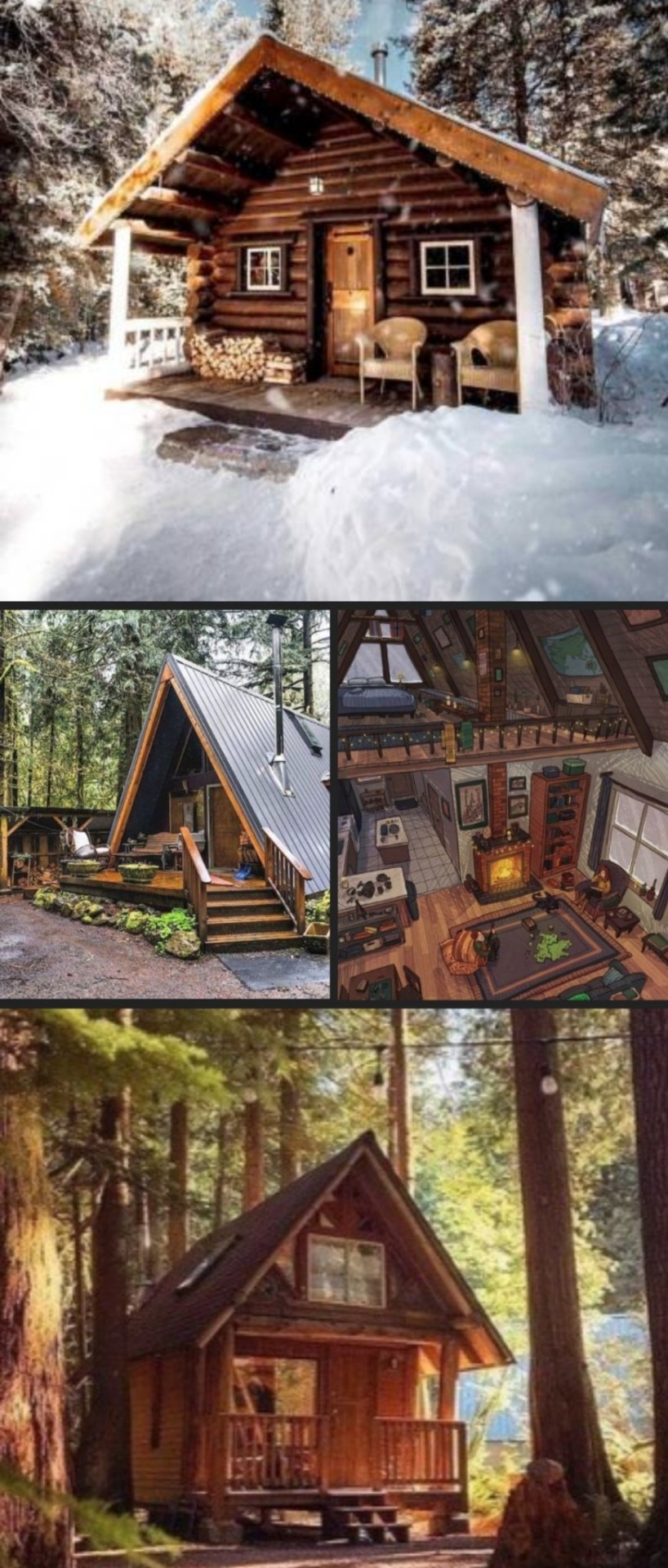
The idea is for the whole community to be gridless with individual power setups based on the terrain around the homes, meaning solar, hydro, biogas digester, etc. The longhouse gets two power systems, one either hydro or solar, with a woodgas generator backup. The land immediately surrounding each home should be gardens and livestock shifting into native forests. Silviculture would be a community effort with constant renewal of the forest and supporting wildlife.
While not 100% self sufficient (nothing really is) this supportive community with homegrown food surrounded by a healthy forest could easily go extended periods of time without needing to leave, while operating on a very low cost of living.
#self sufficiency#self reliance#prepper#off grid#fjarlsland#cabins#a frame#timberframe#wood gas#biogas
101 notes
·
View notes
Text
Young liberals, Jews, PoC and the LGBTQ community especially all need to learn to be as passionate (but logical and practical with it not in a fanaticist way) about things like prepping, business investing, properly farm animal raising and game slaughtering and meat safekeeping, fishing, local politics, keeping currency in hard format, hunting, trapping, survivalism, community and self defense as all the old white conservative people are. Being able to survive is a goal we need even more than they do during a crisis be it political or natural. We don't have to fill our brains with junk about the Rapture or the latest racism and conspiracy theories in order to realize it is important to be self sufficient. When they see us not as just pure subhumans they see us as a naturally weak group who should be punished for that, and that is not the reality but culturally it often feels so because in areas where these pockets of homesteading culture and rural self sufficiency are common, it can be more I know dangerous to be yourself.
But even in an ideal world with no hostility in ideological or political divides whatsoever- lets just say everyone already in your area magically gets along, and won't have any qualm what your background is... are you gonna wanna be stuck without knowledge what to do, if there is a wildfire consuming the area, or a tornado, or a war?
My anxiety stems from the fact so little prepper companies are not just straight Trump supportive money dumpers into conservative interests.
And don't me wrong I think its awesome we packed our stats full on the compassion, sex health education, mental health community, cultural exploration, arts and music and theater and literary side of things.
But having the ability to sew clothes or build a shelter or preserve food or shoot a rabid skunk so it doesn't bite your dog kinda is a big deal tool also.
And in reality these never should be "separate demographics/types of worlds" anyway. Whether you are urban, suburban or rural in lifestyle, I think these are vital skills and knowledge we should all be imparted with, at very young age regardless.
We can and should have both our love of the abstract creative and digital culture planes, AND a love for the hardnosed "blue collar" material plane as well.
7 notes
·
View notes
Link
This dude built a shelter for his dog before building his own. The perfect human.
#RamizInTheWild#survivaladventure#wintershelter#outdoors#outdoor living#preppers#homestead#camping#offgrid#survivalism#survivalist#nature#manandhisdog#dogs of tumblr#bushcraft#explore the outdoors#bushcraft skills#shelter building#cabin in the woods#forest#woods#furrycompanion#youtube discovery
2 notes
·
View notes
Photo
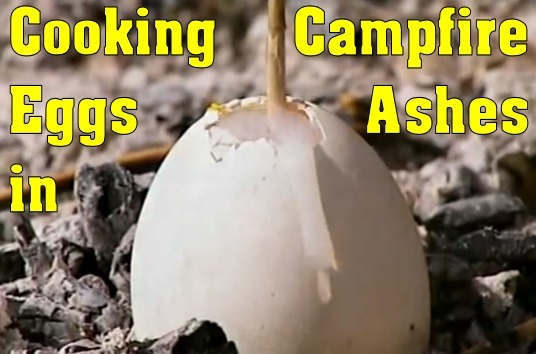
Cook a Raw Egg, in its Shell, in Campfire Ashes:
When a cooking pot or pan is unavailable in the wild, the wood charcoal ashes of a campfire will do just fine to cook an egg that may have been found in a nest.
With a knife or rock, carefully peck a hole (1/4 - 1/2 inch) in one end of the egg shell.
If you want to spice up the taste, add salt, pepper or herbs in the hole and stir the inside with a small stick or shake the egg with your thumb over the hole.
Place the egg (hole up) on hot camp fire [white] ashes (NOT red coals). No need to pack ashes completely around the egg.
The egg will cook from the bottom up so when the egg in the hole has turned white (about 40 minutes for a standard chicken egg), it's ready to eat after letting it cool.
[Video]
[Reference Link]
Related Resources:
Dining Under the Sun and Stars - Primitive and Solar Cooking
Survival Uses for Charcoal
Uses For Wood Ashes
[14-Point Emergency Preps Checklist]
[11-Cs Basic Emergency Kit]
[Learn to be More Self-Sufficient]
[The Ultimate Preparation]
[5six7 Menu]
#eggCookedinShell#food#campfire#prepper#survival#shtf#eggs#campfireEggs#charcoal#ashes#ash#wood ashes#campfire eggs
9 notes
·
View notes
Text
"The whole thing is so fucked up to me,' Mira said. And so childish. Like, it basically just comes down to you just wanting to make a mess of the planet, and then not wanting to take responsibility for the clean-up, so instead you, like, build this little fortress for yourself so that when the shit really hits the fan, you can just run and hide, and nobody can hold you accountable for anything you did. Right? I mean, people talk so much shit about the "nanny state", but what kind of person makes a huge mess and then has to get someone else to clean it up? A baby. Someone with a fucking nanny.'"
- Eleanor Catton, Birnam Wood
2 notes
·
View notes
Text
2 notes
·
View notes
Text
Here’s the video we created out in the wood with an apocalyptic zombie horror movie vibe. Staring Rahyndee
youtube
#zombies#zombie#end times#post apocalyptic#apocalypse#camo#camouflage#cinema#art#artsy#short film#woods#nature#bikini babe#actors#youtube#survival#prepper
0 notes
Text
NYT's Notable Books of 2023
Each year, we pore over thousands of new books, seeking out the best novels, memoirs, biographies, poetry collections, stories and more. Here are the standouts, selected by the staff of The New York Times Book Review.
AFTER SAPPHO by Selby Wynn Schwartz
Inspired by Sappho’s work, Schwartz’s debut novel offers an alternate history of creativity at the turn of the 20th century, one that centers queer women artists, writers and intellectuals who refused to accept society’s boundaries.
ALL THE SINNERS BLEED by S.A. Cosby
In his earlier thrillers, Cosby worked the outlaw side of the crime genre. In his new one — about a Black sheriff in a rural Southern town, searching for a serial killer who tortures Black children — he’s written a crackling good police procedural.
THE BEE STING by Paul Murray
In Murray’s boisterous tragicomic novel, a once wealthy Irish family struggles with both the aftermath of the 2008 financial crash and their own inner demons.
BIOGRAPHY OF X by Catherine Lacey
Lacey rewrites 20th-century U.S. history through the audacious fictional life story of X, a polarizing female performance artist who made her way from the South to New York City’s downtown art scene.
BIRNAM WOOD by Eleanor Catton
In this action-packed novel from a Booker Prize winner, a collective of activist gardeners crosses paths with a billionaire doomsday prepper on land they each want for different purposes.
BLACKOUTS by Justin Torres
This lyrical, genre-defying novel — winner of the 2023 National Book Award — explores what it means to be erased and how to persist after being wiped away.
BRIGHT YOUNG WOMEN by Jessica Knoll
In her third and most assured novel, Knoll shifts readers’ attention away from a notorious serial killer, Ted Bundy, and onto the lives — and deaths — of the women he killed. Perhaps for the first time in fiction, Knoll pooh-poohs Bundy's much ballyhooed intelligence, celebrating the promise and perspicacity of his victims instead.
CHAIN-GANG ALL-STARS by Nana Kwame Adjei-Brenyah
This satire — in which prison inmates duel on TV for a chance at freedom — makes readers complicit with the bloodthirsty fans sitting ringside. The fight scenes are so well written they demonstrate how easy it might be to accept a world this sick.
THE COVENANT OF WATER by Abraham Verghese
Verghese’s first novel since “Cutting for Stone” follows generations of a family across 77 years in southwestern India as they contend with political strife and other troubles — capped by a shocking discovery made by the matriarch’s granddaughter, a doctor.
CROOK MANIFESTO by Colson Whitehead
Returning to the world of his novel “Harlem Shuffle,” Whitehead again uses a crime story to illuminate a singular neighborhood at a tipping point — here, Harlem in the 1970s.
THE DELUGE by Stephen Markley
Markley’s second novel confronts the scale and gravity of climate change, tracking a cadre of scientists and activists from the gathering storm of the Obama years to the super-typhoons of future decades. Immersive and ambitious, the book shows the range of its author’s gifts: polyphonic narration, silken sentences and elaborate world-building.
EASTBOUND by Maylis de Kerangal
In de Kerangal’s brief, lyrical novel, translated by Jessica Moore, a young Russian soldier on a trans-Siberian train decides to desert and turns to a civilian passenger, a Frenchwoman, for help.
EMILY WILDE’S ENCYCLOPAEDIA OF FAERIES by Heather Fawcett
The world-building in this tale of a woman documenting a new kind of faerie is exquisite, and the characters are just as textured and richly drawn. This is the kind of folkloric fantasy that remembers the old, blood-ribboned source material about sacrifices and stolen children, but adds a modern gloss.
ENTER GHOST by Isabella Hammad
In Hammad’s second novel, a British Palestinian actor returns to her hometown in Israel to recover from a breakup and spend time with her family. Instead, she’s talked into joining a staging of “Hamlet” in the West Bank, where she has a political awakening.
FORBIDDEN NOTEBOOK by Alba de Céspedes
A best-selling novelist and prominent anti-Fascist in her native Italy, de Céspedes has lately fallen into unjust obscurity. Translated by Ann Goldstein, this elegant novel from the 1950s tells the story of a married mother, Valeria, whose life is transformed when she begins keeping a secret diary.
THE FRAUD by Zadie Smith
Based on a celebrated 19th-century trial in which the defendant was accused of impersonating a nobleman, Smith’s novel offers a vast panoply of London and the English countryside, and successfully locates the social controversies of an era in a handful of characters.
FROM FROM by Monica Youn
In her fourth book of verse, a svelte, intrepid foray into American racism, Youn turns a knowing eye on society’s love-hate relationship with what it sees as the “other.”
A GUEST IN THE HOUSE by Emily Carroll
After a lonely young woman marries a mild-mannered widower and moves into his home, she begins to wonder how his first wife actually died. This graphic novel alternates between black-and-white and overwhelming colors as it explores the mundane and the horrific.
THE HEAVEN & EARTH GROCERY STORE by James McBride
McBride’s latest, an intimate, big-hearted tale of community, opens with a human skeleton found in a well in the 1970s, and then flashes back to the past, to the ’20s and ’30s, to explore the town’s Black, Jewish and immigrant history.
HELLO BEAUTIFUL by Ann Napolitano
In her radiant fourth novel, Napolitano puts a fresh spin on the classic tale of four sisters and the man who joins their family. Take “Little Women,” move it to modern-day Chicago, add more intrigue, lots of basketball and a different kind of boy next door and you’ve got the bones of this thoroughly original story.
A HISTORY OF BURNING by Janika Oza
This remarkable debut novel tells the story of an extended Indo-Ugandan family that is displaced, settled and displaced again.
HOLLY by Stephen King
The scrappy private detective Holly Gibney (who appeared in “The Outsider” and several other novels) returns, this time taking on a missing-persons case that — in typical King fashion — unfolds into a tale of Dickensian proportions.
A HOUSE FOR ALICE by Diana Evans
This polyphonic novel traces one family’s reckoning after the patriarch dies in a fire, as his widow, a Nigerian immigrant, considers returning to her home country and the entire family re-examines the circumstances of their lives.
THE ILIAD by Homer
Emily Wilson’s propulsive new translation of the “Iliad” is buoyant and expressive; she wants this version to be read aloud, and it would certainly be fun to perform.
INK BLOOD SISTER SCRIBE by Emma Törzs
The sisters in Törzs's delightful debut have been raised to protect a collection of magic books that allow their keepers to do incredible things. Their story accelerates like a fugue, ably conducted to a tender conclusion.
KAIROS by Jenny Erpenbeck
This tale of a torrid, yearslong relationship between a young woman and a much older married man — translated from the German by Michael Hofmann — is both profound and moving.
KANTIKA by Elizabeth Graver
Inspired by the life of Graver’s maternal grandmother, this exquisitely imagined family saga spans cultures and continents as it traces the migrations of a Sephardic Jewish girl from turn-of-the-20th-century Constantinople to Barcelona, Havana and, finally, Queens, N.Y.
LAND OF MILK AND HONEY by C Pam Zhang
Zhang’s lush, keenly intelligent novel follows a chef who’s hired to cook for an “elite research community” in the Italian Alps, in a not-so-distant future where industrial-agricultural experiments in America’s heartland have blanketed the globe in a crop-smothering smog.
LONE WOMEN by Victor LaValle
The year is 1915, and the narrator of LaValle’s horror-tinged western has arrived in Montana to cultivate an unforgiving homestead. She’s looking for a fresh start as a single Black woman in a sparsely populated state, but the locked trunk she has in stow holds a terrifying secret.
MONICA by Daniel Clowes
In Clowes’s luminous new work, the titular character, abandoned by her mother as a child, endures a life of calamities before resolving to learn about her origins and track down her parents.
THE MOST SECRET MEMORY OF MEN by Mohamed Mbougar Sarr
Based on a true story and translated by Lara Vergnaud, Sarr’s novel — about a Senegalese writer brought low by a plagiarism scandal — asks sharp questions about the state of African literature in the West.
THE NEW NATURALS by Gabriel Bump
In Bump’s engrossing new novel, a young Black couple, mourning the loss of their newborn daughter and disillusioned with the world, start a utopian society — but tensions both internal and external soon threaten their dreams.
NORTH WOODS by Daniel Mason
Mason’s novel looks at the occupants of a single house in Massachusetts over several centuries, from colonial times to present day. An apple farmer, an abolitionist, a wealthy manufacturer: The book follows these lives and many others, with detours into natural history and crime reportage.
NOT EVEN THE DEAD by Juan Gómez Bárcena
An ex-conquistador in Spanish-ruled, 16th-century Mexico is asked to hunt down an Indigenous prophet in this novel by a leading writer in Spain, splendidly translated by Katie Whittemore. The epic search stretches across much of the continent and, as the author bends time and history, lasts centuries.
THE NURSERY by Szilvia Molnar
“I used to be a translator and now I am a milk bar.” So begins Molnar’s brilliant novel about a new mother falling apart within the four walls of her apartment.
OUR SHARE OF NIGHT by Mariana Enriquez
This dazzling, epic narrative, translated from the Spanish by Megan McDowell, is a bewitching brew of mystery and myth, peopled by mediums who can summon “the Darkness” for a secret society of wealthy occultists seeking to preserve consciousness after death.
PINEAPPLE STREET by Jenny Jackson
Jackson’s smart, dishy debut novel embeds readers in an upper-crust Brooklyn Heights family — its real estate, its secrets, its just-like-you-and-me problems. Does money buy happiness? “Pineapple Street” asks a better question: Does it buy honesty?
THE REFORMATORY by Tananarive Due
Due’s latest — about a Black boy, Robert, who is wrongfully sentenced to a fictionalized version of Florida’s infamous and brutal Dozier School — is both an incisive examination of the lingering traumas of racism and a gripping, ghost-filled horror novel. “The novel’s extended, layered denouement is so heart-smashingly good, it made me late for work,” Randy Boyagoda wrote in his review. “I couldn’t stop reading.”
THE SAINT OF BRIGHT DOORS by Vajra Chandrasekera
Trained to kill by his mother and able to see demons, the protagonist of Chandrasekera’s stunning and lyrical novel flees his destiny as an assassin and winds up in a politically volatile metropolis.
SAME BED DIFFERENT DREAMS by Ed Park
Double agents, sinister corporations, slasher films, U.F.O.s — Park’s long-awaited second novel is packed to the gills with creative elements that enliven his acerbic, comedic and lyrical odyssey into Korean history and American paranoia.
TAKE WHAT YOU NEED by Idra Novey
This elegant novel resonates with implication beyond the taut contours of its central story line. In Novey’s deft hands, the complex relationship between a young woman and her former stepmother hints at the manifold divisions within America itself.
THIS OTHER EDEN by Paul Harding
In his latest novel, inspired by the true story of a devastating 1912 eviction in Maine that displaced an entire mixed-race fishing community, Harding turns that history into a lyrical tale about the fictional Apple Island on the cusp of destruction.
TOM LAKE by Ann Patchett
Locked down on the family’s northern Michigan cherry orchard, three sisters and their mother, a former actress whose long-ago summer fling went on to become a movie star, reflect on love and regret in Patchett’s quiet and reassuring Chekhovian novel.
THE UNSETTLED by Ayana Mathis
This novel follows three generations across time and place: a young mother trying to create a home for herself and her son in 1980s Philadelphia, and her mother, who is trying to save their Alabama hometown from white supremacists seeking to displace her from her land.
VICTORY CITY by Salman Rushdie
Rushdie’s new novel recounts the long life of Pampa Kampana, who creates an empire from magic seeds in 14th-century India. Her world is one of peace, where men and women are equal and all faiths welcome, but the story Rushdie tells is of a state that forever fails to live up to its ideals.
WE COULD BE SO GOOD by Cat Sebastian
This queer midcentury romance — about reporters who meet at work, become friends, move in together and fall in love — lingers on small, everyday acts like bringing home flowers with the groceries, things that loom large because they’re how we connect with others.
WESTERN LANE by Chetna Maroo
In this polished and disciplined debut novel, an 11-year-old Jain girl in London who has just lost her mother turns her attention to the game of squash — which in Maroo’s graceful telling becomes a way into the girl’s grief.
WITNESS by Jamel Brinkley
Set in Brooklyn, and featuring animal rescue workers, florists, volunteers, ghosts and UPS workers, Brinkley’s new collection meditates on what it means to see and be seen.
Y/N by Esther Yi
In this weird and wondrous novel, a bored young woman in thrall to a boy band buys a one-way ticket to Seoul.
YELLOWFACE by R.F. Kuang
Kuang’s first foray outside of the fantasy genre is a breezy and propulsive tale about a white woman who achieves tremendous literary success by stealing a manuscript from a recently deceased Asian friend and passing it off as her own.
236 notes
·
View notes
Text


Well, this one got me. Looks like a normal 1976 Mid-century modern in South Range, WI. The back reminds me of a motel, but it does have a whopping 9bds, 4ba, so it's a large home. $1.1M.
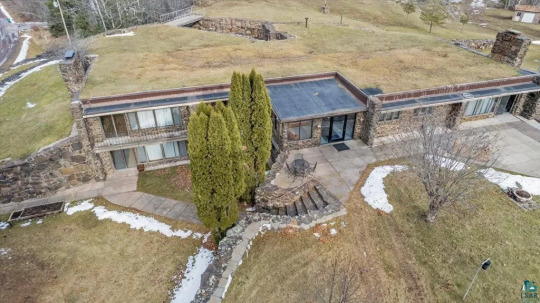
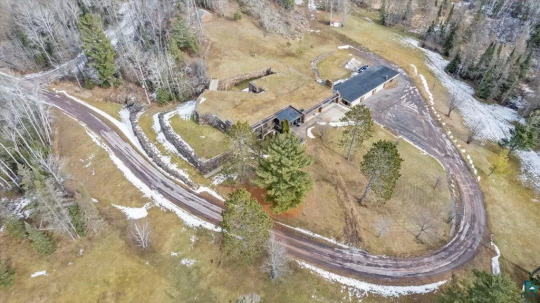
But, that was just the front & back. The entire middle of the house is underground. The Realtor Description says: Structure Type: Earth Home & Characteristics (Muck (?), Undeveloped, Elevation-Low, etc.) MUCK? That doesn't sound good. We must see the interior.

The entrance. Wait a minute, this is a hotel- the doors have numbers. WTF? The description says "built by preppers for preppers," and "many features 'just in case.'" Oh, like whoever, or whatever, can't come thru the glass front.

This house really took me by surprise. It looks like a commune, but each floor has its own living setup, and is supposed to be like a 3 family home.


So, this is unit #1's kitchen. Typical MCM style.

The bedrooms don't have separate baths. So, it's 1 bath per unit.


This floor has a sauna & shower room.

Huge living room. Like the Zombie Apocalypse couldn't just open the sliding doors.

Kitchen in the lower level, which is unit 2.

The bath.

One of the bedrooms. They're pretty roomy and each one has a different configuration.

Living room in the back of the house for unit 2.


Unit 3 kitchen.
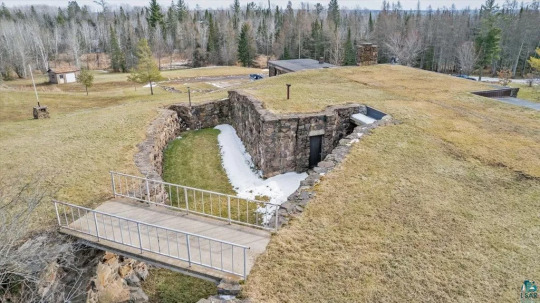
I was wondering what this is, is it some sort of bunker?

Unit 3 is in the basement level. By the look of the various welcome mats, all of these rooms are occupied separately.

Game room.

2 sets of washers & dryers.

What, no giant cans of food? This is really just a boarding house.

The power room. Just one water heater for 9 bedrooms? Heat is a combination of wood & propane.

Large patio.
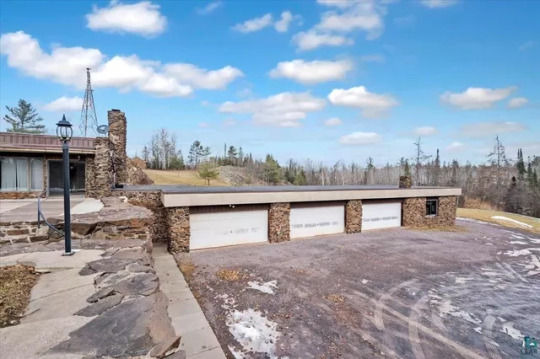
8 car garage. The tower in the background is an old wind generator.

This was a generator house that's now empty.
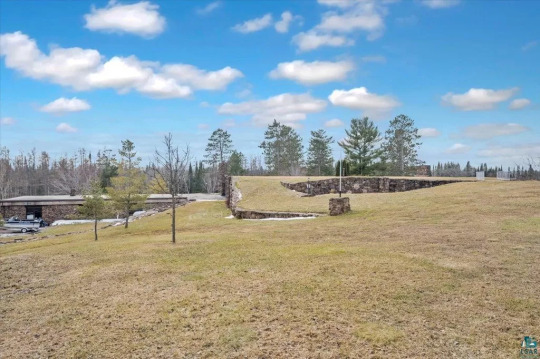
Shooting range to practice shooting the intruders.

80 acres of land- so the property is huge.
https://www.trulia.com/home/5312-s-stone-rd-south-range-wi-54874-79382055
108 notes
·
View notes
Text
New fire kit from me is up on the website. All you need in a compact kit.
#prepper#prepping#bushcraft#prepper in the woods#survival#edc#prepperinthewoods#fire#camping#youtuber#firestarting#edc fire kit#bushcraft cooking#bushcraftkit#bushcrafter
3 notes
·
View notes
Text
Some books and stories that I think are worth reading in conversation with Yellowjackets
Shirley Jackson, all works but especially The Sundial, The Haunting of Hill House, and We Have Always Lived in the Castle. Jackson might or might not need any introduction in this fandom. The Sundial is her take on doomsday preppers, Hill House is of course her haunted house novel (one of the classics of that genre), and Castle has a female protagonist who makes Shauna look like a plaster saint.
Flannery O'Connor, The Violent Bear It Away. O'Connor's work has some of the most pervasive darkness and brutality of any major American writer (maybe Ambrose Bierce comes close), and the second of two novels that she completed before her death is no exception. (The first, Wise Blood, is also very good; the intended third, Why Do the Heathen Rage?, only exists as a fragmentary short story.) Francis Marion Tarwater is kidnapped and raised in the woods by his great-uncle, who is convinced that Francis is destined to be a prophet. The great-uncle's death commences a bizarre adventure involving auditory hallucinations, sinister truckers, an evil social worker, arson, developmental disabilities, and baptizing and drowning someone at the same time. Content warnings for all of the above plus rape. O'Connor is also a fairly racist author by today's standards--she was a white Southerner who died in 1964--so keep that in mind as well.
Ruth Ozeki, The Book of Form and Emptiness. Teenage protagonist is schizophrenic and also a channel for a genuinely supernatural force; well-intentioned but poorly-considered efforts to treat one of these issues make the other worse. Sound familiar? There are supporting characters who are affectionate parodies of Slavoj Zizek and Marie Kondo. A minor character is a middle-aged lesbian who cruises dating apps for hookups with much younger women. Some people find this book preachy and overwritten, but I really like it and would plug it even if I didn't because the author is someone whom I've met and who has been supportive of my own writing.
Yukio Mishima, The Decay of the Angel. Can be read in translation or in the original Japanese. This is the fourth and last book in a series called The Sea of Fertility but I wouldn't necessarily recommend the first three as particularly YJ-ish; Decay is because it deals at great length with issues of doubt and ambiguity about whether or not a genuinely held, but personally damaging, spiritual and religious belief is true. There's also more (as Randy Walsh would put it) lezzy stuff than is usual for Mishima, a gay man. Content warnings for elder abuse, sexual abuse of both children and vulnerable adults in previous books in the series, forced abortion in the first book if you decide to read the whole thing from the beginning, and the fact that in addition to being a great novelist the author was also a far-right political personality.
Howard Frank Mosher, Where the Rivers Flow North. An elderly Vermont lumberjack and his Native American common-law wife refuse to sell their land to a development company that wants to build a hydroelectric power plant. Tragedy ensues. I haven't read this one in a long time but some images from the movie stick in my mind as YJ-y. Lots of fire, water, and trees.
Leonard Cohen, Beautiful Losers. Yes, this is the same Leonard Cohen who later transitioned into songwriting and became a household name in that art form. Beautiful Losers is a very weird, very horny novel that he wrote as a young man; it deals with the submerged darkness and internal tension within Canadian and specifically Quebecois society. One of the main characters is Kateri Tekakwitha, a seventeenth-century Iroquois convert to Catholicism who was probably a lesbian in real life (although Cohen unfortunately seems unaware of this). This one actually shows up YJ directly; the song "God Is Alive, Magic Is Afoot" that plays in the season 2 finale takes its lyrics from a particularly strange passage.
Monica Ojeda, Jawbone. Can be read in translation or in the original Spanish. Extremely-online teenage girls at a posh bilingual Catholic high school in Ecuador start their own cult based on such time-honored fodder as Herman Melville novels, internet creepypasta (no, this book does not look or feel anything like Otherside Picnic), and their repressed but increasingly obvious desire for one another. The last part in particular gets the attention of their English teacher, whose own obsessive internalized homophobia grows into one of the most horrifying monstrous versions of itself I've ever read. Content warning for just about everything that could possibly imply, but especially involuntary confinement, religious and medical abuse, and a final chapter that I don't even know how to describe. Many thanks to @maryblackwood for introducing me to this one.
Jorge Luis Borges, lots of his works but especially "The Aleph," "The Cult of the Phoenix," and "The South." Can be read in translation or in the original Spanish. The three works I list are all short stories. The first deals with mystical experiences and the comprehensibility (or lack thereof) of the universe, the second with coded and submerged references to sexuality in general and homosexuality in particular, the third with leaving your well-appointed city home for a ranch in the middle of nowhere and almost immediately dying in a knife fight, which is surely a very YJ series of things to do.
H.P. Lovecraft, "The Colour out of Space," "The Dunwich Horror," "The Dreams in the Witch House," and "The Thing on the Doorstep." Lovecraft in general needs no introduction--the creepiness, the moroseness, the New Englandness, the purple heliotrope prose, his intense racism (recanted late in life but not in time to make any difference in his reception history) and the way his work reflects his fear of the Other. These short stories are noteworthy for having settings that are more woodsy and less maritime than is usual for Lovecraft's New England, for overtones of the supernatural rather than merely the alien, for featuring some of his few interesting female characters, and for their relative lack of obvious racial nastiness. Caveat lector nevertheless.
Herman Melville, Moby-Dick. It's Moby-Dick. Once you realize that Captain Ahab is forming a cult around the whale and his obsession with it you can't unrealize it.
196 notes
·
View notes
Note
If the members of the Gaang were all content creators on YouTube, what would their individual channels be about?
Ooo...so I vaguely remember answering a similar ask like two years ago or something like that. I don't know if that actually happened, or if it was a conversation I was part of, or a really vivid dream. If it is something I've answered before, I will not swear that these are the exact same answers as the first time.
Katara: Foraging. She has a very popular, but very niche channel explaining how to find edible plants in the wild. Her fans joke that she is secretly a doomsday prepper, but in reality she is aware of how fast someone can become food insecure or homeless and her goal is to help at least a few people facing that reality get by.
Sokka: Hunting and gaming. A lot of his YT content is cross posted from his Twitch channel. He does a lot of video game streaming, but on occasion, he'll post video he takes from camping and hunting with his dad. Katara joins occasionally (or he and their father will appear in her videos), but it's mostly something he and his father share. Those hunting videos are rare (like less than 5 posts a year), but they are his most popular videos because of how genuinely sweet he and Hakoda are together.
Toph: I see her being really into drumming in a universe where she has a YT account, so her content would mostly be play alongs, or original works. She might even become another Dave Grohl.
Zuko: I don't see him being a YT personality himself, but he's actually really good at video editing, so he might help Iroh, who has a Mister Rogers style show.
Suki: She has a cult following for her self defense videos. She has a series where she shows women simple moves to incapacitate attackers. One day she invites three women who have survived various situations (domestic abuse, a mugging, encountering a random man in the woods) where they used self defense techniques they learned from Suki, and Suki's channel takes off too the point where she can make YT her full time job.
Aang: he starts off doing reviews of vegan restaurants that's getting decent enough views, but then he veers into more militant vegan content. A lot of his subscribers drop off, but the ones that remain are intensely loyal.
41 notes
·
View notes
Text
Uncovering the unreleased Far Cry 5 in-game Encyclopedia
The almost complete but unused in-game encyclopedia, reconstructed thanks to the oasisstrings file.
Please note that it’s still cut content, so some information might not be relevant anymore.
You can read the oasisstrings file here. Pictures from this encyclopedia were also extracted and posted by @xbaebsae here.
Part 6: Characters
Aaron "Tweak" Kirby
Uppers, downers, sideway-ers... Tweak is all about pushing the limits of the human condition.
Adelaide Drubman
A confident go-getter with deep pockets to do whatever she wants, like living with booze, bazookas, and boy toy Xander Flynn.
Bo Adams
A hardcore survivalist that chooses to live out in the woods and off the grid.
Boomer
A scruffy pal with unparalleled loyalty.
Cameron Burke
A U.S. Marshal with an agenda. The only thing standing between him and his political aspirations is the Project at Eden's Gate.
Casey Fixman
A grill cook with a classified past. Most locals don’t believe his outrageous war stories or the wisdom he serves up with every order.
Chad Wolanski
A self-styled prepper chef who sells food out of his food truck since his restaurant "The Grill Streak" burned down.
Dr. Charles Lindsey
A veterinarian drafted into service as a medic. There's no one else to do it, and aren't we all animals?
Cheeseburger
Orphaned as a cub and raised by Wade Fowler, he's the star attraction at the F.A.N.G. Center. He loves eating cheeseburgers.
Clutch Nixon
A legendary stuntman who left this world the way he entered it: Face first onto a pile of rocks.
Dave Fowler
Wade Fowler's brother, he runs the business end of the F.A.N.G. Center.
Richard "Dutch" Roosevelt
An old prepper who'd worked himself to the bone and lost everything even before Eden's Gate came to town. Same shit, different horse.
Dylan
(no description found)
Eli Palmer
A bonafide prepper and the leader of the Whitetail Militia. He helped Eden's Gate design their survival bunkers before he wised up.
Faith Seed
The Siren in the East. The youngest in the Seed family pacifies unruly followers to make way for the Collapse. Some believe she's only an illusion.
George Wilson
George is a Whitetail Militia and baseball enthusiast, but spends most of this time as a lookout because of his age.
Grace Armstrong
A medal-winning shooter and army sniper with a vendetta against Eden’s Gate.
Guy Marvel
A genius movie director envisioning a masterpiece of anarchy and gold statue wins. Even an auteur needs help to make movie magic.
Deputy Joey Hudson
One of your fellow Hope County Deputies who has absolutely no time for bullshit and has the fists to back herself up.
Hurk Drubman Jr.
His wit and intellect may have been blunted by paint huffing, but that hasn't stopped him from living a life of adventure.
Hurk Drubman Sr.
A retired oil baron who is the undisputed master of his domain... what's left of it after the divorce.
Jacob Seed
The Soldier in the North. The eldest Seed brother serves Joseph by creating the army that will defend the Project with their lives.
Pastor Jerome Jeffries
The local man of God who will do whatever it takes to protect the people of Hope County – even if it costs him his soul.
Jess Black
Dutch’s niece. Jess is a loner who nearly lost her life in Jacob's camps, only to discover a new talent in the process: killing Peggies.
John Seed
The Baptist in the West. The youngest of the Seed brothers, John is in charge of reaping the land of supplies that will help the Project survive.
Joseph Seed
The Father. The middle Seed brother heard a Voice that told him to initiate a great Project, to prepare for the Collapse of everything. And so he has.
Kim Rye
A world traveler who chose Hope County to put down roots, and those roots are on the way - she's in her third trimester.
Larry Parker
Genius or crackpot? Science will decide.
Mary May Fairgrave
The tough-as-nails barkeep who blames Eden's Gate for the death of her parents.
Merle Briggs
A local prepper. Merle could talk your ears off about his dream bunker, or the shelf life of canned goods.
Wilhelmina Mable
Wilhelmina Maybelline, big cat whisperer and taxidermist. The well-being of Peaches the cougar is her top priority.
Nadine Abercrombie
The last living member of a family of hoarders, though she considers herself a collector. Much classier than simply hoarding. And more selective.
Nancy
(no description found)
Nick Rye
The best dang pilot in Hope County. Give him a chance and he'll put on a show.
Peaches
The long-time pet of Miss Mable. Probably named for the color of her fur and not the sweet disposition she lacks.
Deputy Stacy Pratt (yes, his first name is actually spelled Stacy in the files)
One of your fellow Hope County Deputies who’s a good cop when his ego doesn't get in the way.
Dr. Sarah Perkins
A lone biologist determined to unravel the mysteries of how Jacob's Judge wolves are created.
Sharky Boshaw
A wanted arsonist, Charlemange Victor Boshaw IV hides out where he can live his fire-blazing, rockstar fantasies.
Sherri Woodhouse
She gave up city life, opened a fishing store, and began the hunt for her family’s missing legendary whiskey.
Skylar Kohrs
A high-powered expert fly fisher hell-bent on landing a legendary fish.
Tammy Barnes
Once a homemaker, now the chief interrogator for the Whitetail Militia. They say her marshmallow blondies are to die for.
Tracey Lader
A woman determined to bring down Eden's Gate, especially Faith. They used to be friends and the sting of betrayal fuels her wrath.
Virgil Minkler
A trusted mayor for the past 7 terms, now hell-bent on stopping the production of Bliss after it took the life of his son.
Wade Fowler
The co-owner of the F.A.N.G. Center, an animal rescue facility that takes in orphaned wild animals.
Walker
A member of Eli's Whitetail Militia.
Wendell Redler
He made it through Nam with his buddies. Now he’s an old man, his buddies are gone, and this is not the America he fought for in his youth.
Wheaty
The smart-ass quartermaster for the Whitetail Militia who also has a radio broadcast to counter the Father's propaganda.
Earl Whitehorse
The devoted sheriff of Hope County. He believes delivering justice with a gun should be a last resort. On the eve of his retirement, duty calls.
Willis Huntley
Just a man in love with the good ol' US of A.
Xander Flynn
Left California for Hope County to detox from the city life. Ended up finding "modeling" gigs at the Drubman Marina, and a cult cramping his style.
Zip Kupka
A self-proclaimed conspiracy "realist" who finds a new reason to hate the government with each passing day.
There were three more:
Coyote Nelson
Fishing is life.
In the files, Coyote Nelson is the name of the fisherman you meet at fishing spots.
Morris
A bright kid of Blackfoot heritage and the go-to person for all things computers and arcade machines. He keeps it on the down low.
The character’s full name apparently is Morris Aubrey. He’s the person who’s always near Far Cry Arcade machines and telling you how “awesome” the game is.
Scooter
A supply runner for the Whitetail Militia.
All I know about Scooter is that, according to a deleted mission objective, this character (who was also cut) was supposed to be escorted to the Wolf’s Den at some point.
#far cry 5#well I can’t and therefore won’t tag everyone here but at least a few (the 'main' ones):#adelaide drubman#boomer#cameron burke#cheeseburger#richard 'dutch' roosevelt#eli palmer#faith seed#grace armstrong#joey hudson#hurk drubman jr#jacob seed#jerome jeffries#jess black#john seed#joseph seed#kim rye#mary may fairgrave#nick rye#peaches#staci pratt#stacy pratt#sharky boshaw#tammy barnes#tracey lader#wheaty#earl whitehorse#willis huntley
42 notes
·
View notes
Photo

Wood Cutting/Splitting/Breaking Safety:
Anyone who relies on wood heat for the home, camping or survival needs to understand precautions in cutting, splitting and breaking wood to prevent injury and save time and physical energy.
Protect eyes, hands and feet, tie back long hair, remove loose-fitting jewelry, wear long sleeve shirt (tight cuffs) and long pants.
Learn how to properly use any tools or equipment (ax, hatchet, maul, wedge, chain saw or wood splitter) before use.
Keep fingers away from any tool in motion.
Keep children and pets away from the work area.
Have a second person to assist to increase safety, decrease injury and call for help if someone is injured.
Have others stand back when tools are in use to reduce potential injury from flying shards of wood or metal.
Never operate any machinery when you've been using alcohol/drugs or if you're feeling ill or very tired.
Cutting Firewood in 2-inches slices (like a pie), instead of splitting it length-wise, may be easier on the back. It will dry faster and naturally split halfway through.
In a camping or survival mode, tools may not be available to cut wood for a fire and resorting to "breaking" it may be necessary. Unnecessary risk is not a good idea. A sprained ankle or gash in the hand can severely hamper the ability to effect survival. As good as a fire is, getting injured in the process of gathering firewood is not worth it. Forget breaking wood over any body part (knee, etc.) or slamming it against a tree to cause flying debris. The fork of a tree is much better option. Knowing how to break wood without injury is knowledge worth having.
Splitting Wood Safely
Splitting Wood Quickly with a Fiskars
How to Safely Fell a Tree with a Chainsaw

Cutting Small Fire Logs can be challenging and dangerous (especially when using a chainsaw). Keeping the log secure, and not moving around, can be done with a Log Cutting Holder. There are many commercial versions but P4T is all about self-reliance and DIY so this one fit the bill for me. Determine the maximum diameter of log you'll want to cut. Logs that are larger than 6" in diameter are, probably, going to be heavy enough to not move around easily. The angle of the legs is entirely up to you and based on the log diameter. Making them angled too far out will lower the log closer to the ground and would be less room for the saw to move (especially a hand saw). On the other hand making the legs too close to each other will make the device less stable, so you have to find a middle ground. The legs in the photo [above] are about 26" long.
Log Cutting Tools are useful for making a difficult task easier. Learning how to properly use these tools will make the task even easier and safer. The following tools are recommended to learn for proper use:
Axe
Sledgehammer and Wedge
Hatchet (portable)
Bow Saw
Chainsaw [Video 1] [Video 2]
Saws-All (Reciprocating Saw)
Log Splitter - reduces the size of logs for use in a fire (fireplace or woodstove). Gas-powered and manual versions are available.
[Reference Link]
[14-Point Emergency Preps Checklist]
[11-Cs Basic Emergency Kit]
[Learn to be More Self-Sufficient]
[The Ultimate Preparation]
#firewood#woodCuttingSafety#prepper#survival#shtf#diy#logCuttingHolder#firewoodCuttingHolder#woodCuttingTools#toolsWoodCutting#tools#wooden it be nice#cutting wood safely#wood cutting safety#breaking wood safely
4 notes
·
View notes